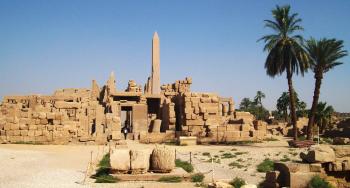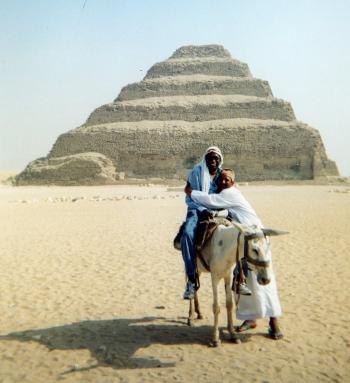Understanding the allure of Egypt
This article appears on page 36 of the November 2019 issue.
I had been to Egypt on four previous occasions. My first and second visits took place a little more than 10 years ago, and both trips were the result of Fulbright scholarships I had been awarded to study the history and culture of Egypt.
Five years after my second trip, I was back in the country again, this time courtesy of an educational grant I’d received to produce an educational video for the Advanced Placement history classes I taught.
I spent that summer traveling throughout Egypt shooting video footage, and it was a very rewarding and interesting time for me on both a professional and personal level.
My fourth trip was purely personal.
For my latest visit, in December 2018, I decided to travel independently, wanting the freedom and flexibility that solo travel allows. (For those who enjoy traveling with a group, Global Exploration for Educators [Norristown, PA; 877/600-0105, geeo.org] is my favorite company.) I also wanted to retrace some of my earlier travels, from Lower Egypt to Upper Egypt and across the Red Sea into the Sinai Peninsula.
Inspiring a visit
Egypt has always beckoned adventurers, wanderlust travelers, artists and writers among its many visitors. It seems there is a special allure the country exerts on the imagination.
The name “Egypt” conjures up images of monumental structures — temples, pyramids, mastabas and tombs — but there is more to Egypt than its historical monuments. It is a country that offers a variety of activities for travelers to indulge their interests and passions.
The Sinai Peninsula, with its many settlements and resorts, provides a picturesque backdrop for those simply wanting to relax in the warmth and soak in the area’s ambience. It also provides action and adventure for travelers interested in scuba diving or snorkeling.
But then, as now, it is the world’s longest river, the Nile, that has defined this ancient land. In addition to providing much-needed water for farming, the Nile also serves as a major means of transportation and of relaxation for the Egyptian people.
One of my most unforgettable moments in Cairo was taking a relaxing and invigorating felucca ride on the Nile following an earlier day of very intense activity. With the cool breeze blowing off the river, it was as if I had been transported back in time.
More to see
For those wanting to indulge their passions for culture and entertainment, there are a number of sightseeing spots in Cairo that can consume much of your day.
And for others who enjoy shopping and bazaars, there are various souks, including Khan el-Khalili, one of the largest in the Middle East. There, one can find a wide assortment of shops crammed with art objects, ceramics, spices, and textiles and carpets of all sizes, colors and descriptions (and merchants determined to get you to buy their merchandise!).
For all of the people who have read the book “The Yacoubian Building” or seen the movie of the same title, I would suggest taking a quick trip to see what now remains of the titular site.
Located in downtown Cairo on Talaat Harb Street, the now-decaying building is a far cry from its glory days, when it served as Cairo’s chic place to be. However, it still evokes the era when it served as a meeting place for the rich and powerful, where deals were struck and careers were made or lost.
Accommodations
For all of my trips to Egypt, The President Hotel in Cairo (actually in Zamalek, an island suburb of Cairo) and the Windsor Palace Hotel in Alexandria served as bases of operations.
I enjoyed my stays at The President (22 Taha Hussein; www.thepresidentcairo.com) due to its location, ambience and various amenities, not to mention the staff, whom I came to know well. And the price was reasonable ($56 to $70 per night).
I have a special fondness and sentimentality for The Windsor (17, El Shohada St.) because it was there that I enjoyed some of my most memorable moments in Egypt. I also enjoy its location, looking out over the Mediterranean Sea, and its interior design is a throwback to the days of its elegant beginnings.
The Windsor is located approximately one mile from the Alexandria Library (a “must see” if you are in Alexandria) and close to the El Ramil train station. (I took the train from Cairo to Alexandria and found the ride to be rather enjoyable.) Room prices range from $75 to over $100 per night.
Grand sites
The major reason, however, that people travel to Egypt is to see its monumental structures and its mummies. I never grow tired of visiting Egypt’s ancient wonders — the mastaba of Saqqara, the Giza Pyramid Complex, the Step Pyramid of Djoser, the Theban Necropolis and the Karnak Temple Complex — and they never cease to amaze me, no matter how many times I have seen them!
I can still vividly remember the first time I saw the pyramids of Giza. It was an absolutely unforgettable experience! I just stood there motionless, looking up at the Great Pyramid, transfixed by this staggering engineering feat.
And then there was the enigmatic sphinx! I stood before it somewhat transfixed, looking at this rather strange statue with the body of a lion and the head of a man.
But before there were the pyramids, there were the mastabas of Saqqara. Known as “bench pyramids,” mastabas were the forerunners of the pyramids most visited today. The Saqqara site is one of Egypt’s earliest and largest burial sites, and it is worthy of a visit.
The Theban Necropolis, located in Upper Egypt in the modern-day city of Luxor, is a must-see place for visitors. Located within the Theban Necropolis are the two famous sites known as the Valley of the Kings and the Valley of the Queens.
Also located in Luxor is one of the largest religious centers in the world, the Karnak Temple Complex, a mixture of temples, chapels, pylons and obelisks. With its Hypostyle Hall, it is the second-most-visited site in Egypt, and whenever I am in Egypt, I always make it a point to go to Karnak. It is simply an amazing place!
The Sinai Peninsula
Outside of the temples, pyramids and mastabas, there are plenty of other sites and places to visit in Egypt. Chief among them are the sites of the Sinai Peninsula.
Mount Sinai, where, according to the Bible, Moses spoke face to face with God and received the Ten Commandments, is a principal site.
I have climbed the mountain twice, and it is not an easy climb if you’re not in good physical condition. I can still recall a friend of mine who’d climbed the mountain later telling me, jokingly, that with each step he took on his way up, he was cursing my name for my having encouraged him to climb it in the first place.
In the end, he succeeded in reaching the summit and was very proud of that fact… but he also vowed he wouldn’t do it again!
Each time I left to reach the summit of Mt. Sinai, my departure point was St. Catherine’s Monastery. I left the monastery early in the morning for the hike to its summit. The hike took several hours. Once at the summit, I waited for the breaking of dawn and the appearance of the sun to witness what some people believe to be a sacred moment.
However, there is more to do in and around the Sinai Peninsula if you are not into hiking up a mountain. There are several Red Sea resort towns, such as Sharm el-Sheikh, Dahab (my favorite), Taba and Hurghada, where you can participate in activities such as windsurfing, snorkeling, scuba diving or simply enjoying the sand, surf, water and warm, dry climate.
Alexandria
Finally, there is Alexandria, one of my favorite cities in Egypt. It is famous for two ancient wonders: the famed Pharos Lighthouse of Alexandria, at one time the second-tallest man-made structure in the world, and the Great Library of Alexandria, considered during its heyday as the center of learning in the ancient world. With thousands of books and manuscripts, it was used by scholars and historians from around the ancient Mediterranean as a reference source.
Neither of those two sites exists today, but the modern-day library in Alexandria is well worth visiting.
Due to its Greco-Roman heritage, Alexandria contains the largest Greco-Roman necropolis in Egypt. I had the opportunity to visit the Catacombs of Kom El Shoqafa in Alexandria and found them to be well worth the time and effort.
The city’s amphitheater is well known for its acoustics. I took some friends there and told them to sit anywhere in the amphitheater while I stood on a central piece of rock and spoke in a normal voice, and they could clearly hear me.
However, if I didn’t stand in that spot, my voice was not audible to anyone. It was an interesting experience!
Egypt is a country that continues to beckon me to return, and when I do, I am never disappointed!


